Troubleshooting The Pelleting Process: Part 2
Development Of Pellet Quality
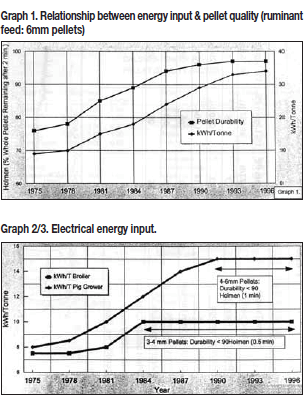
In response to demand for better quality pellets, engineering process technology has responded by applying greater amounts of electrical energy per ton of pelleted feed -- more so for ruminant and pig than for poultry. Graph 1 and 2/3 show, over a 20 year period, how pellet quality has improved in relation to electrical energy input at the pelleting plant (excluding steam, cooler and conveyors). Thus, we can see that pellet quality is relative to energy input and we can use this criteria when trouble shooting. Fundamental Requirements For Good Pellet Quality And Production Rate There are just two! That is, assuming adequate grinding and conditioning.
1. A good feed formulation.
2. Sufficient Specific Energy (kWh/ton) used
by the pellet press motor.
These are the first two stages of investigation used that are recommended to investigate when troubleshooting either Pellet Quality or Production Rate problems.
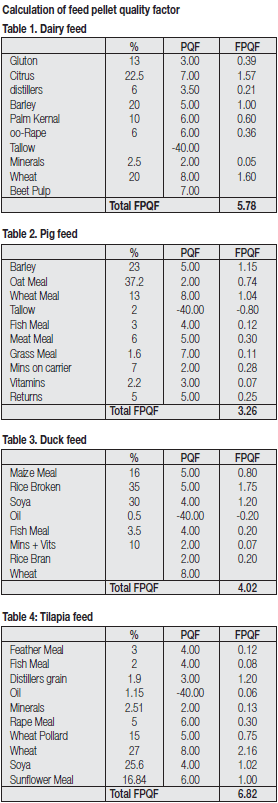
Stage 1
Determination Of The Formulation’s "Feed Pellet Quality Factor" (FPQF)
The first step to take when trouble shooting is
to calculate FPQF. If it is higher than your level
of acceptability, then you know the problem is
in the feedmill. If it is lower, then discuss it with
your nutritionist or feed formulator.
Determination of FPQF can be used:
A. as a formulating tool to predict pellet quality!
B. as a production tool to maximize production rate!
A. Let us first take a look at feed raw materials and their influence on physical pellet quality. Knowing that some raw materials pellet well, wheat for example, and some are very difficult e.g., grain screenings, it should be possible from experience to given each raw material a Pellet Quality Factor; 0 for bad, 10 for good. I say from experience because pelleting each raw material as a "straight" and ascribing a value to it in order to calculate the pelletability of a mixture, does not always work out correctly. There is, without doubt, a synergy between raw materials which we do not yet fully understand.
The values listed for various raw materials are given in the table on page 40 of "The Pelleting Handbook" , published by Borregaard Ligno Tech. Clearly, if a feed formulation can be identified as potentially difficult before it gets into production, then a great deal of time and money can be saved. However, it should be stressed that the results from calculations should only be used as guidelines.
As an example, Tables 1, 2, 3 and 4, show the FPQF calculation of a ruminant, pig, duck and Tilapia feed formulation, respectively. The process of calculating the Feed Pellet Quality Factor (FPQF) for any given formulation is straightforward. List the raw materials used in the formulation with their respective % inclusion and Pellet Quality Factor (taken from The Pelleting Handbook or your own modified version). Then, multiply the PQF by the % inclusion of the raw material e.g., Wheat meal: PQF 8: Inclusion 30%. Therefore, its contribution to the overall FPQF = 8 x 30% = 2.4. Add all the FPQF’s together and their total represents the Feed Pellet Quality Factor for that particular feed formulation.
When using a conventional pelleting line with no expander, if the result is below 5, there could be a pellet quality problem, if it is below 4.7, then the probability of a problem is very high. The tolerance between 4.7 and 5 takes into account the effectiveness and pelleting technique of the feed mill, some mills need to be "5" or over to make good pellets, while others could tolerate a lower level. It is suggested, therefore, that producers of pelleted feeds set their own FPQF level based on nutritional production circumstances and raw materials in relation to the level of pellet quality acceptability. When using an Expander, lower FPQF’s can be tolerated.
B. Calculating FPQF also provides a means of deciding production strategy. If FPQF is 5 or over, it generally indicates that the formulation will be easy to condition, therefore more steam can be added. It also indicates that Pellet Quality should be good, therefore, production rate can be maximized.
Stage 2
Determination Of Specific Energy (kWh/T Pellet Press Motor)
If good quality pellets are to be produced, then the pellet press has to impart a given quantity of
energy. Graphs 1 and 2 show the amount required -- all things being equal, higher pellet quality
requires greater energy input. To produce poultry, pig and ruminant pellets of acceptable durability
at an acceptable production rate, then at least 10, 12/15 and 20/25 kWh/T, respectively must be
used by the pellet press motor. For fin fish and shrimp feed, around 12 kWh/T is required.
The second stage, therefore, in a trouble shooting effort to solve a pellet quality/production rate
problem is to determine the kWh/T of the feed formulation in question. But first check the die to
ensure that the holes are not blocked or rolled over. If the kWh/T value is found to be lower than that
required, it suggests that the die is not working hard enough. Possibly, it is worn out or simply that
its compression length is insufficient. If the value is equal to, or higher than that required, then the
fault must lay somewhere else in the plant, such as grinding or conditioning.
To determine kWh/T (units of electrical energy used by the pellet press motor to produce one tone of pellets) the production rate in ton/hour must be known as well as voltage and the average amperage used by the pellet press. To calculate production rate, determine the amount of time it takes to produce a given quantity of feed and calculate tons/hour. Then apply the following formula to calculate power (kW) being taken by the pellet press motor.
kW = Average pellet press motor amperage x Voltage x 1.73 x Power Factor
1000
Assume a Power factor of 0.93 unless known.
Specific Energy Consumption (kWh/T) = kW / T/h
Relationship Between Pellet Press Motor
Amperage, Specific Energy Consumption
And Pellet Quality
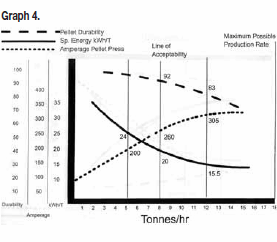
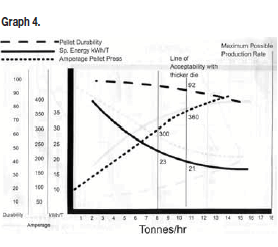
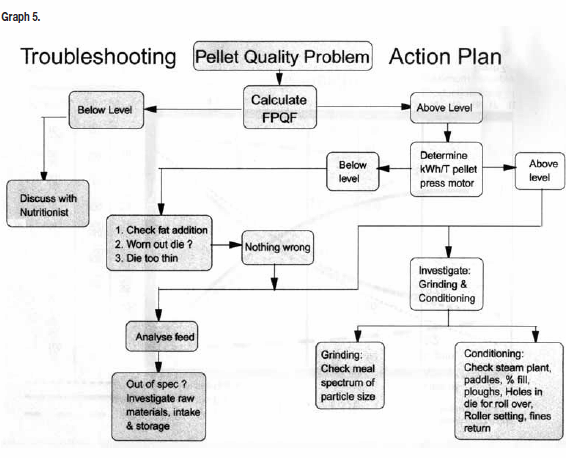
So if the feed formulation and specific energy input are found to be adequate, according to your standards, then it will be necessary to move on to stage 3.
Stage 3
Check Conditioning
Grinding: "Conditioning" starts with grinding the feed raw materials. Grinding finer produces better
quality pellets. Measure the "Meal spectrum of particle size" of the meal mixture which is to be pelleted
and compare it with the following suggested spectrum:
Meal particles on a 3.00mm sieve up to 1%
" " on a 2.00mm sieve up to 5%
" " on a 1.00mm sieve around 20%
" " on a .50mm sieve around 30%
" " on a .25mm sieve around 24%
Throughs (flour) Not less than 20%
The sieve analysis not only indicates if the meal is too coarse, it also identifies grinding problems e.g., punctured or badly worn grinder screens. If your meal is much coarser than that suggested or is not as well balanced, the only solution is to fit grinder with screens having smaller perforations or a combination of screen sizes to improve balance. Check meal spectrum of particle size regularly and avoid fitting new beaters and screens together.
Conditioning: Steam/moisture is the critical factor, but if the mixer conditioner is not working effectively, the benefit from producing good quality steam will be wasted. Therefore, ensure that the conditioner is running as full as possible by adjusting the angle of its beaters or possibly reducing the speed. The objective is for the meal, liquids and steam to rub together -- they must be persuaded, not beaten. It is essential that heat and moisture is transferred from steam to meal as fast and as evenly as possible.
The factors which influence this are:
1. Quality steam
2. Steam velocity entering the conditioner
3. Location of the steam pipe entering the conditioner
4. Volume of meal in the conditioner
Steam should be "dry" at entry to the conditioner i.e., no water droplets. These should have been taken out by the separator. The pressure of steam should be set to suit requirements -- generally around 4 Bar pressure for ruminant and other fibrous feeds, and around 1 to 2 bar for starchy type of feeds. However, the writer suggests setting your pressure to suit your circumstances depending on the moisture content of your meal prior to conditioning. If your meal is predominantly dry, then use low pressure steam for all types of feed, but ensure the diameter of the steam pipe, after reducing the valve, is big enough to carry the volume at low velocity (20 m/sec) required to optimize meal temperature and moisture. Best results are obtained when steam enters the conditioner via its end plate through a manifold. The steam reducing valve should be at least six meters upstream from entry to the conditioner.
So, if you are satisfied that everything so far meets with requirements, then the last stage has to reveal the problem.
Stage 4
Check out the following main problem areas:
1. Fines return are large pieces or whole pellets returned to the pellet press -- possible hole in sifter
screen, See amperage trace Fig. 3 -- recorded in an Israel feedmill.
2. Are you allowing any raw materials to by-pass the grinder e.g., soy or pelleted products? (Sieve
analysis will reveal this).

3. Analyze finished product for oil and protein -- if out of spec., check feed raw materials and storage
silos. Possible carry over of one raw material into another.
4. Check temperature and moisture of pellets leaving cooler. These should be at a level which you
know the product can be stored without risk of deterioration.
5. Are you adding water? Water doe not disperse well. It creates wet-spots which cause pellets to
degrade during storage.
6. Are you adding other liquids e.g., fat, molasses? Check to ensure these are dispersed evenly.
7. Ensure that both (all) rollers in the pelleting machine are positioned correctly and the plough/s are
not badly worn/fitted. Uneven pellet length is an indication that something is wrong. Check again
to ensure the holes are not rolled over.




